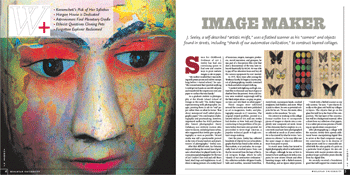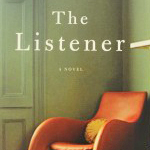Image Maker
 Since his childhood, Professor of Art J. Seeley has had one continuing quest: to find new and creative ways to print realistic images in ink on paper. “My mother recalled that I was working with potato prints and rubber stamps long before I started school,” he says. “She remembered that I pushed anything I could get my hands on into felt ink pads and transferred the impression onto any paper or surface that was handy.”
Since his childhood, Professor of Art J. Seeley has had one continuing quest: to find new and creative ways to print realistic images in ink on paper. “My mother recalled that I was working with potato prints and rubber stamps long before I started school,” he says. “She remembered that I pushed anything I could get my hands on into felt ink pads and transferred the impression onto any paper or surface that was handy.”
As a graduate student in photography at the Rhode Island School of Design in the early ’70s, Seeley began experimenting with photographic images, printing them in ink on “real” paper rather than on what he terms “that shiny waterproof stuff called photographic paper.” His combination of photography and printmaking, however, impressed neither his RISD professor (the famed photographer Harry Callahan) nor celebrity visitors who came to classes, including Diane Arbus, who suggested that Seeley give up photography as soon as possible. “Mixed media was still a questionable pursuit in the eyes of many teachers and practitioners of photography,” Seeley says.
After that difficult start, his fortunes improved during the second year of graduate school when he played hooky to become principal photographer for the tour of Joe Cocker’s hot rock-and-roll blues band, Mad Dogs and Englishmen. In addition to taking pictures of a motley band of musicians, singers, managers, producers, record executives, and groupies, he was part of a four-person film crew that shot a documentary of the tour, later released theatrically by MGM. He was able to pay off his education loans and buy all the camera equipment he ever wanted.
In 1975, three years after joining the Wesleyan faculty, he began a six-year project of photographing models costumed in black-and-white striped clothing.
“I worked with lighting and high contrast film to eliminate any trace of gray or shadow from the pictures. Form and contour were rendered surprisingly well by the black stripes alone?no gray, no grain, no tone, just rich black on white paper.”
These images were exhibited around the country and were published as art in magazines, books, and photography annuals in 17 countries. The original striped portfolio, printed in a limited edition of 110, sold out. Seeley had dealers in New York and Chicago contracting to buy portfolios of his pictures before they were even printed. He proceeded to write High Contrast, a popular technical guide to high-contrast image-making.
Over the years, Seeley has collected hundreds of objects for use in his photographs that he has found in the streets, at flea markets, or at yard sales. He is especially fond of crushed pieces from cars that he recovered from the base of the local Arrigoni Bridge, which he calls “shards of our automotive civilization.” His collection includes old game boards, balls and marbles, mounted butterflies, rusted tools, mannequin heads, crushed eyeglasses, bird feathers, and more. What is junk to others, he sees as potential subjects for his art. “To me, the exotic often resides in the mundane,” he says.
His interest in working in the collage format enables him to incorporate pieces of images or objects into a completely new composite art work. Some of the elements that he employs in a recent work may have been photographed or collected as much as 25 years earlier. He is fascinated by what he terms “variations on a theme,” so he may often use the same image or object in different ways from print to print.
In recent years Seeley has turned to digital photography, which is well-suited to his collages. Although he was at first reluctant to have anything to do with a computer, he now creates vibrant and often haunting images with a flatbed scanner, PhotoShop, and an Epson inkjet printer.
“I work with a flatbed scanner as my only camera,” he says. ”I put objects directly on the glass and build my collages in layers. The objects that go on the glass first will be in the front of the composition. The last layer of the construction will be a background material, often a sheet from my collection of art papers. It is a rather precarious process of building an upside-down composition.”
After photographing a collage with the scanner, Seeley then spends additional hours manipulating digital files to arrive at the final composite image. He sometimes has to do dozens of inkjet prints until he is reasonably satisfied with the color quality of a print on a particular kind of paper. He also collaborates with master printers who can produce larger and better prints directly from his digital files.
He recently received a foundation grant that will support his creative work for the next five years. As a frequent speaker at universities around the country, he has observed a great deal of student work and concluded that Wesleyan students’ photography is as good or better than that of other students, even those in the top art schools. Last year he had the unusual distinction of being invited to address both leading professional photography educational organizations: the Photo Imaging Education Association International Conference and the National Conference of the Society for Photography Education, where he entertained participants with an overview of the highs and lows of his career, entitled “35 Years as an Artistic Misfit.” This talk proved so successful that he has presented it to Wesleyan alumni clubs in Seattle and San Francisco and at the Center for the Arts.
Seeley’s highly-sought-after classes concentrate on shooting good photographs rather than making perfect prints. “Printing is important, but it is always possible to hire someone to print for you. If you’re going to become a professional photographer, you must do your own shooting,” he says. Seeley spends at least half a day each week reviewing students’ contact sheets to give them advice on improving their work, and he customizes weekly lectures to the specific needs and interests of his students. He particularly encourages his students to work with and learn from each other. They often pair up to shoot a roll of film or collaborate with students involved in other media or subjects unrelated to art.
Last year was especially gratifying for Seeley. Six of his students—Alexandra (Sasha) Rudensky ’01, Jennifer Rizzuto Congregane ’01, Eleanor Michael ’01, Colleen Will ’03, Matthew Earp ’01, and Colleen Galbraith ’03—were awarded prizes of valuable camera equipment and film from a competition sponsored by the Photo Imaging Education Association. Their pictures were included in a traveling exhibition in five countries in 2001 and 2002. (Seeley was also awarded the grand prize for faculty/staff in the same competition.) In addition, Rudensky was awarded the first annual Leica Camera/Jim Marshall Photo Scholarship for her series of images of Russia, which were part of her senior thesis. She received $2,500 and a Leica camera outfit.
Lindsay Dickinson ’01, who received high honors for her creative thesis, says: “He is a giving and dedicated teacher and is genuinely invested in the success of his students. His advice always points me in the right direction, yet is openended enough to allow my own ideas to generate and develop independently. Working as a photography lab assistant and looking through work of past students, I saw that his teaching seems to consistently yield work of amazing quality and creativity.”
After leaving Wesleyan, his students frequently achieve distinction, including fine art photographers Mark Steinmetz ’82, whose work has appeared at the Museum of Modern Art; Lyle Ashton Harris ’88, whose images have been shown at the Whitney Museum of American Art; Joanne Lukitsh ’76, a photohistorian and an associate professor of art history at Massachusetts College of Art; Brooks Kraft ’87, a nationally recognized photojournalist whose pictures of President Bush have appeared in Time magazine; Mayita Mendez ’96, a photojournalist cited by Photo District News as one of “30 Emerging Photographers to Watch”; and Barbara Woike ’79, New York City photo editor at the Associated Press.
See the magazine Web site for samples of work by J. Seeley’s students.


